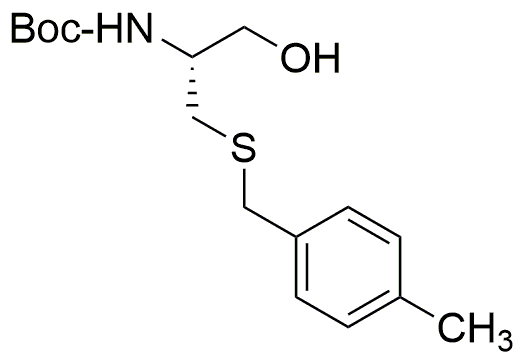Boc-S-4-methylbenzyl-L-cysteinol is widely utilized in research focused on:
- Peptide Synthesis: This compound serves as a protecting group in the synthesis of peptides, allowing for selective reactions while preserving the integrity of other functional groups.
- Drug Development: Its unique structure makes it valuable in the design of novel pharmaceuticals, particularly in creating compounds that target specific biological pathways.
- Bioconjugation: The compound can be used to attach biomolecules to surfaces or other molecules, enhancing the development of targeted therapies and diagnostics in the biomedical field.
- Antioxidant Research: Researchers explore its potential as an antioxidant, which can be beneficial in developing supplements or treatments aimed at reducing oxidative stress.
- Material Science: It is applied in the formulation of advanced materials, contributing to the development of coatings and polymers with enhanced properties.
General Information
Properties
Safety and Regulations
Applications
Boc-S-4-methylbenzyl-L-cysteinol is widely utilized in research focused on:
- Peptide Synthesis: This compound serves as a protecting group in the synthesis of peptides, allowing for selective reactions while preserving the integrity of other functional groups.
- Drug Development: Its unique structure makes it valuable in the design of novel pharmaceuticals, particularly in creating compounds that target specific biological pathways.
- Bioconjugation: The compound can be used to attach biomolecules to surfaces or other molecules, enhancing the development of targeted therapies and diagnostics in the biomedical field.
- Antioxidant Research: Researchers explore its potential as an antioxidant, which can be beneficial in developing supplements or treatments aimed at reducing oxidative stress.
- Material Science: It is applied in the formulation of advanced materials, contributing to the development of coatings and polymers with enhanced properties.
Documents
Safety Data Sheets (SDS)
The SDS provides comprehensive safety information on handling, storage, and disposal of the product.
Product Specification (PS)
The PS provides a comprehensive breakdown of the product’s properties, including chemical composition, physical state, purity, and storage requirements. It also details acceptable quality ranges and the product's intended applications.
Certificates of Analysis (COA)
Search for Certificates of Analysis (COA) by entering the products Lot Number. Lot and Batch Numbers can be found on a product’s label following the words ‘Lot’ or ‘Batch’.
Numéro de catalogue
Numéro de lot/série
Certificates Of Origin (COO)
This COO confirms the country where the product was manufactured, and also details the materials and components used in it and whether it is derived from natural, synthetic, or other specific sources. This certificate may be required for customs, trade, and regulatory compliance.
Numéro de catalogue
Numéro de lot/série
Safety Data Sheets (SDS)
The SDS provides comprehensive safety information on handling, storage, and disposal of the product.
DownloadProduct Specification (PS)
The PS provides a comprehensive breakdown of the product’s properties, including chemical composition, physical state, purity, and storage requirements. It also details acceptable quality ranges and the product's intended applications.
DownloadCertificates of Analysis (COA)
Search for Certificates of Analysis (COA) by entering the products Lot Number. Lot and Batch Numbers can be found on a product’s label following the words ‘Lot’ or ‘Batch’.
Numéro de catalogue
Numéro de lot/série
Certificates Of Origin (COO)
This COO confirms the country where the product was manufactured, and also details the materials and components used in it and whether it is derived from natural, synthetic, or other specific sources. This certificate may be required for customs, trade, and regulatory compliance.


